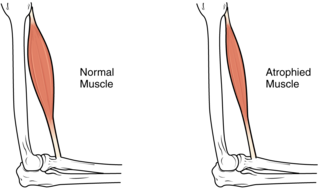
Exercise or workout is physical activity that enhances or maintains fitness and overall health. which is performed for various reasons, including weight loss or maintenance, to aid growth and improve strength, develop muscles and the cardiovascular system, prevent injuries, hone athletic skills, improve health, or simply for enjoyment. Many people choose to exercise outdoors where they can congregate in groups, socialize, and improve well-being as well as mental health.

Aerobic exercise, also known as cardio, is physical exercise of low to high intensity that depends primarily on the aerobic energy-generating process. "Aerobic" is defined as "relating to, involving, or requiring oxygen", and refers to the use of oxygen to meet energy demands during exercise via aerobic metabolism adequately. Aerobic exercise is performed by repeating sequences of light-to-moderate intensity activities for extended periods of time. According to the World Health Organization, over 31% of adults and 80% of adolescents fail to maintain the recommended levels of physical activity. Examples of cardiovascular or aerobic exercise are medium- to long-distance running or jogging, swimming, cycling, stair climbing and walking.

Jogging is a form of trotting or running at a slow or leisurely pace. The main intention is to increase physical fitness with less stress on the body than from faster running but more than walking, or to maintain a steady speed for longer periods of time. Performed over long distances, it is a form of aerobic endurance training.

Physical fitness is a state of health and well-being and, more specifically, the ability to perform aspects of sports, occupations, and daily activities. Physical fitness is generally achieved through proper nutrition, moderate-vigorous physical exercise, and sufficient rest along with a formal recovery plan.
Basal metabolic rate (BMR) is the rate of energy expenditure per unit time by endothermic animals at rest. It is reported in energy units per unit time ranging from watt (joule/second) to ml O2/min or joule per hour per kg body mass J/(h·kg). Proper measurement requires a strict set of criteria to be met. These criteria include being in a physically and psychologically undisturbed state and being in a thermally neutral environment while in the post-absorptive state (i.e., not actively digesting food). In bradymetabolic animals, such as fish and reptiles, the equivalent term standard metabolic rate (SMR) applies. It follows the same criteria as BMR, but requires the documentation of the temperature at which the metabolic rate was measured. This makes BMR a variant of standard metabolic rate measurement that excludes the temperature data, a practice that has led to problems in defining "standard" rates of metabolism for many mammals.

Anaerobic exercise is a type of exercise that breaks down glucose in the body without using oxygen; anaerobic means "without oxygen". This type of exercise leads to a buildup of lactic acid. In practical terms, this means that anaerobic exercise is more intense, but shorter in duration than aerobic exercise.
Overtraining occurs when a person exceeds their body's ability to recover from strenuous exercise. Overtraining can be described as a point where a person may have a decrease in performance and plateauing as a result of failure to consistently perform at a certain level or training load; a load which exceeds their recovery capacity. People who are overtrained cease making progress, and can even begin to lose strength and fitness. Overtraining is also known as chronic fatigue, burnout and overstress in athletes. It is suggested that there are different variations of overtraining, firstly monotonous program over training suggest that repetition of the same movement such as certain weight lifting and baseball batting can cause performance plateau due to an adaption of the central nervous system which results from a lack of stimulation. A second example of overtraining is described as chronic overwork type training where the subject may be training with too high intensity or high volume and not allowing sufficient recovery time for the body. Up to 10% of elite endurance athletes and 10% of American college swimmers are affected by overtraining syndrome.

Strength training, also known as weight training or resistance training, involves the performance of physical exercises that are designed to improve physical strength. It is often associated with the lifting of weights. It can also incorporate a variety of training techniques such as bodyweight exercises, isometrics, and plyometrics.

High-intensity interval training (HIIT) is a training protocol alternating short periods of intense or explosive anaerobic exercise with brief recovery periods until the point of exhaustion. HIIT involves exercises performed in repeated quick bursts at maximum or near maximal effort with periods of rest or low activity between bouts. The very high level of intensity, the interval duration, and number of bouts distinguish it from aerobic (cardiovascular) activity, because the body significantly recruits anaerobic energy systems. The method thereby relies on "the anaerobic energy releasing system almost maximally".
Aerobic conditioning is the use of continuous, rhythmic movement of large muscle groups to strengthen the heart and lungs, as well as changes to the skeletal muscles. Improvement in aerobic conditioning occurs when athletes expose themselves to an increase in oxygen uptake and metabolism, but to keep this level of aerobic conditioning, the athletes must keep or progressively increase their training to increase their aerobic conditioning.

Physical activity is defined as any voluntary bodily movement produced by skeletal muscles that requires energy expenditure. Physical activity encompasses all activities, at any intensity, performed during any time of day or night. It includes both voluntary exercise and incidental activity integrated into the daily routine. This integrated activity may not be planned, structured, repetitive or purposeful for the improvement of physical fitness, and may include activities such as walking to the local shop, cleaning, working, active transport etc. Lack of physical activity is associated with a range of negative health outcomes, whereas increased physical activity can improve physical and mental health, as well as cognitive and cardiovascular health. There are at least eight investments that work to increase population-level physical activity, including whole-of-school programmes, active transport, active urban design, healthcare, public education and mass media, sport for all, workplaces and community-wide programmes. Physical activity increases energy expenditure and is a key regulator in controlling body weight. In human beings, differences among individuals in the amount of physical activity have a substantial genetic basis.
Abdominal exercises are a type of strength exercise that affect the abdominal muscles. Human abdominal consist of four muscles which are the rectus abdomens, internal oblique, external oblique, and transversus abdominis. When performing abdominal exercises it is important to understand the effects, functions, the types of exercises, and think about how to perform this exercise safely.

Sports nutrition is the study and practice of nutrition and diet with regards to improving anyone's athletic performance. Nutrition is an important part of many sports training regimens, being popular in strength sports and endurance sports. Sports nutrition focuses its studies on the type, as well as the quantity of fluids and food taken by an athlete. In addition, it deals with the consumption of nutrients such as vitamins, minerals, supplements and organic substances that include carbohydrates, proteins and fats.

The following outline is provided as an overview of and topical guide to exercise:

Dance is a healthy physical activity, with many far reaching physical, and psychological benefits. Dancing can be enjoyed in many forms, and is for every age and ability. This physical activity appeals to some who may not typically be active, and therefore may be another alternative of exercise. Dance for health has become an important factor in the prevention, treatment, and management in several health circumstances. It can benefit both physical and mental health and subsidizes social communication Dance is an art which is learned in and shared between many cultures. Types of dance can entail body movements, expression and collaboration. The correlation between dance and health has been subject of a number of research studies that show dance to be a largely healthy exercise. However, there are a number of health risks that require attention.

Water aerobics is the performance of aerobic exercise in water such as in a swimming pool. It is done mostly vertically and without swimming typically in waist deep or deeper water. Water aerobics is a form of aerobic exercise that requires water-immersed participants. Most water aerobics is in a group fitness class setting with a trained professional teaching for about an hour. The classes focus on aerobic endurance, resistance training, and creating an enjoyable atmosphere with music. Different forms of water aerobics include: aqua Zumba, water yoga, aqua aerobics, and aqua jog.

Sarcopenic obesity is a combination of two disease states, sarcopenia and obesity. Sarcopenia is the muscle mass/strength/physical function loss associated with increased age, and obesity is based off a weight to height ratio or body mass index (BMI) that is characterized by high body fat or being overweight.

Weight management comprises behaviors, techniques, and physiological processes that contribute to a person's ability to attain and maintain a healthy weight. Most weight management techniques encompass long-term lifestyle strategies that promote healthy eating and daily physical activity. Weight management generally includes tracking weight over time and identifying an individual's ideal body weight.

Cardiovascular fitness is a component of physical fitness, which refers to a person's ability to deliver oxygen to the working muscles, including the heart. Cardiovascular fitness is improved by sustained physical activity (see also Endurance Training) and is affected by many physiological parameters, including cardiac output (determined by heart rate multiplied by stroke volume), vascular patency, and maximal oxygen consumption (i.e. VO2 max).
The benefits of physical activity range widely. Most types of physical activity improve health and well-being.













